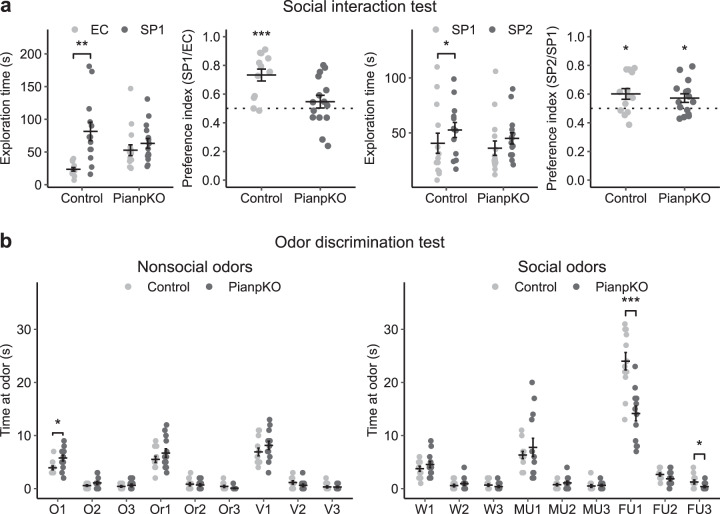Fig. 5.
Pianp deficiency impairs social interaction and social odor discrimination. a In the social interaction test (SIT), PianpKO mice (n = 14) showed equal exploration times at an empty cage (EC) and at a cage with an unknown mouse (t(14) = 0.83, p > 0.05), designated as social partner mouse 1 (SP1), while the controls (n = 12), showed a significantly higher exploration time at SP1 than at the EC (t(12) = 4.08, p < 0.01). Therefore control mice had a statistically significant preference for SP1 (t(12) = 5.63, p < 0.001) that was not present in PianpKO mice (t(14) = 1.07, p > 0.05). Subsequent exposure to the familiar SP1 and to another unknown mouse, designated as social partner mouse 2 (SP2), PianpKO mice (t(14) = 2.38, p < 0.05) and controls (t(12) = 2.71, p < 0.05) both showed a slight, but statistically significant, preference for unknown SP2. However, the exploration times at SP1 and SP2 did only differ statistically significant in the control group (control: t(12) = 2.28, p < 0.05; PianpKO: t(14) = 1.58, p > 0.05). b In the odor discrimination test, PianpKO mice (n = 13) did not show a significant difference in the time spent sniffing the nonsocial odors oil (O2: t(23) = 1.49, p > 0.05; O3: t(23) = 0.69, p > 0.05), apart from the first round (O1: t(23) = 2.75, p < 0.05,), orange (Or1: t(23) = 1.18, p > 0.05; Or2: t(23) = 0.37, p > 0.05; Or3: t(23) = 1.68, p > 0.05), and vanilla (V1: t(23) = 1.16, p > 0.05; V2: t(23) = 1.38, p > 0.05; V3: t(23) = 0.91, p > 0.05) in comparison to the controls (n = 12). However, PianpKO mice spent a significantly shorter time sniffing female urine (FU1: t(23) = 4.59, p < 0.001; FU3: t(23) = 2.15, p < 0.05) compared with the controls (n = 12). However, FU2 did not differ significantly (FU2: t(23) = 1.73, p > 0.05). No significant difference between the groups could be detected for water (W1: t(23) = 1.03, p > 0.05; W2: t(23) = 0.87, p > 0.05; W3: t(23) = 0.99, p > 0.05) and male urine (MU1: t(23) = 0.76, p > 0.05; MU2: t(23) = 0.81, p > 0.05; MU3: t(23) = 0.36, p > 0.05). * p < 0.05, ** p < 0.01, *** p < 0.001, a one sample or two-tailed unpaired t-test, b two-tailed unpaired t-test

